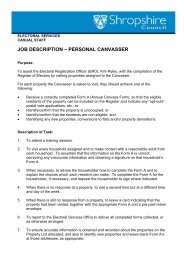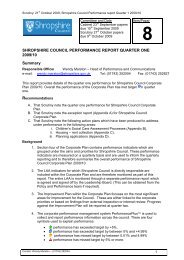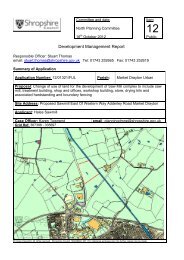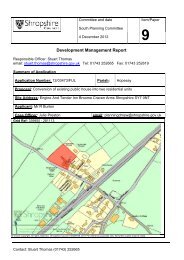6 Questions from Members.pdf - Shropshire Council
6 Questions from Members.pdf - Shropshire Council
6 Questions from Members.pdf - Shropshire Council
Create successful ePaper yourself
Turn your PDF publications into a flip-book with our unique Google optimized e-Paper software.
QUESTION 1<br />
MEMBERS’ QUESTIONS<br />
AGENDA ITEM 6<br />
MR PETER NUTTING will ask the following question:<br />
1<br />
<strong>Council</strong><br />
28 February 2013<br />
Last year (2011/2012) the surplus on the Collection Fund for <strong>Shropshire</strong><br />
<strong>Council</strong> was £2.316 million; this followed surpluses of £498,000 (2009/2010)<br />
and £541,000 (2010/2011).<br />
This surplus was shared between <strong>Shropshire</strong> <strong>Council</strong>, West Mercia Police<br />
Authority and <strong>Shropshire</strong> and Wrekin Fire Authority even though a significant<br />
proportion of the collection fund was collected on behalf of the town and parish<br />
councils in the county, who received nothing.<br />
Based on precepts the Town and Parish <strong>Council</strong>s in <strong>Shropshire</strong> would share<br />
£82,698 of which Shrewsbury Town <strong>Council</strong> would receive £13,448 as per the<br />
attached summary.<br />
The year 2011/2012 was probably slightly out of the normal but a surplus of<br />
around half a million pounds is not uncommon and is probably now more likely<br />
given the risk averse nature of the billing authority at present, who have further<br />
reduced its Collection Rate for 2013/2014. This also has an impact on the<br />
council tax base.<br />
Therefore, will the Leader of the <strong>Council</strong> look into ways of distributing the<br />
surplus on the Collection Fund more fairly and return to the Town and Parish<br />
<strong>Council</strong> sector money collected on its behalf.<br />
Precepts<br />
£<br />
Actual<br />
Distribution of<br />
surplus<br />
£<br />
Revised<br />
Distribution<br />
of surplus<br />
£<br />
<strong>Shropshire</strong> <strong>Council</strong> 128,986,000 1,910,000 1,826,674<br />
West Mercia Police Authority 19,547,000 276,000 276,821<br />
<strong>Shropshire</strong> & Wrekin Fire Authority 9,166,000 130,000 129,807<br />
Parish & Town <strong>Council</strong>s 5,839,492 0 82,698<br />
____________ ___________ __________<br />
163,538,492 2,316,000 2,316,000<br />
Effective surplus per £1 precept 0.0141618<br />
Bridgnorth 518,157 7,338<br />
Broseley 174,615 2,473<br />
Church Stretton & Little Stretton 255,921 3,624<br />
Ellesmere 188,777 2,673<br />
Ludlow 330,988 4,687<br />
Market Drayton 416,080 5,892<br />
Much Wenlock 149,110 2,112<br />
Oswestry 366,000 5,183<br />
Shifnal 353,426 5,005<br />
Shrewsbury 949,575 13,448<br />
Wem 241,502 3,420<br />
Whitchurch 364,637 5,164<br />
Others less than £140,000 1,530,704 21,678<br />
________ _____<br />
5,839,492 82,698
MR KEITH BARROW, the Leader of the <strong>Council</strong> will reply:<br />
There is no statutory mechanism to distribute collection fund surpluses or<br />
deficits amongst local preceptors. Legislation is clear about the mechanism for<br />
distribution amongst major precepting authorities which for <strong>Shropshire</strong> <strong>Council</strong><br />
is limited to West Mercia Police and <strong>Shropshire</strong> and Wrekin Fire and Rescue<br />
Authority.<br />
This arrangement pre dates the unitary authority and was the same legislation<br />
followed by the former District and Borough <strong>Council</strong>s.<br />
Now that <strong>Council</strong> Tax Benefit has been localised and is expressed as <strong>Council</strong><br />
Tax discounts, the risk attached to the Collection Fund has increased and<br />
accordingly collection rates assumptions have been slightly reduced. The<br />
collection rates across the population are expected to be more variable, with a<br />
higher risk of reduced collection rates being borne by the major precepting<br />
authorities potentially in the form of collection fund deficits.<br />
This risk is averaged out as the distribution of the collection fund surplus or<br />
deficit is based upon collection rates across the whole county, and this is the<br />
area covered by the major precepting authorities. To consider distribution at a<br />
local level would also bring into question collection rates at a local level. Before<br />
a local parish council could be given a share of the collection fund surplus or<br />
deficit, it would need to be established what the collection rate is for their local<br />
tax payers, otherwise some Town and Parish <strong>Council</strong>s would be unfairly cross<br />
subsidising others.<br />
Town and Parish <strong>Council</strong>s do not bear a risk and instead receive their precept<br />
at the value they request. This certainty, the lack of a mechanism for<br />
distribution beyond major preceptors and the necessary administration costs<br />
associated with distribution of many small amounts of money are the reasons<br />
for the current arrangements.<br />
QUESTION 2<br />
MR PETER NUTTING will ask the following question:<br />
I represent the Copthorne area of Shrewsbury and both The Kingswood Estate<br />
and The Redwood Estate suffer <strong>from</strong> serious parking problems caused by the<br />
nearby hospitals, and in particular The Royal Shrewsbury Hospital. The<br />
problem is partly due to a shortage of staff parking at the hospital and therefore<br />
some staff choose to leave their cars in nearby residential areas, but also<br />
because in the afternoons between 2.00pm and 4.00pm the visitor car parks at<br />
the hospital are jam packed and there simply is nowhere for cars to be parked<br />
on site. This problem is likely to get worse with the introduction of increased car<br />
parking charges at the hospital, the increase in workload due to the hospital<br />
introducing more day surgery and also an increase in students at the college<br />
facility. I welcome the increase in use of the site as it provides excellent<br />
employment opportunities for local people but the problems of car parking on<br />
site are not being addressed and this is causing distress to local residents.<br />
Swiss Farm Road is a bus route but poor parking means that buses cannot<br />
always use the road and poor parking by hospital staff and visitors near<br />
peoples’ houses mean that residents are often blocked in their drives. The<br />
hospital has planning permission to provide an extra 100 parking spaces but<br />
seems reluctant to do the work required due to financial restraints.<br />
2
Therefore can the portfolio holder look into this problem as a matter of urgency<br />
and ask officers to find ways to help ease the pressure on the local residential<br />
road network.<br />
MR SIMON JONES, the Portfolio Holder for Traffic Management and Road Safety<br />
will reply:<br />
Parking at the Royal Shrewsbury Hospital has been a problem for a number of<br />
years. The major concern is displacement of cars onto local roads and estates.<br />
Many of them are staff, with some visitors also, looking to avoid parking<br />
charges. This is not unique to Shrewsbury and it is common to have these<br />
issues at any major hospital.<br />
The Shrewsbury and Telford NHS Trust are looking to make changes to their<br />
current parking as it reviews the existing travel plan. They are introducing an<br />
Automatic Number Plate Recognition system later this year, which will help to<br />
make more use of the existing parking spaces currently available. They are<br />
also introducing different charges, some to benefit long term patients and more<br />
regular visitors, others to encourage people to use alternatives to cars to get to<br />
the hospital. Simply offering free parking is not the answer; the physical number<br />
of cars for the available spaces is the problem.<br />
As there are proposed changes to charges this has highlighted concern locally,<br />
with a fear that there will more parking pressures placed on local roads. For<br />
this reason <strong>Shropshire</strong> <strong>Council</strong> has been working with the NHS Trust to seek to<br />
minimise these impacts. We are working proactively and considering interim<br />
and longer term measures with the trust. Communication with the hospital has<br />
greatly improved recently and they are looking to appoint someone to<br />
specifically address these problems.<br />
Early last year we undertook a consultation with residents on Swiss Farm<br />
Road, one of the most affected roads. There was a 70% return rate, of these<br />
70% were in favour of some restrictions and 30% against. Of those in favour<br />
there was no clear consensus as to what restrictions to apply. We will continue<br />
to work as closely as possible with residents and the Trust and keep under<br />
review parking in the area. In reality there needs to be an integrated approach<br />
with investment, and changes on the hospital site, integrated travel<br />
arrangements and appropriate parking restrictions. It needs to be a balanced<br />
approach.<br />
At this time the hospital have planning permission <strong>from</strong> 2010 for an additional<br />
60 parking spaces, which they have not completed. They have completed a<br />
191 space temporary car park, for which the temporary permission is about to<br />
lapse. We are discussing the future of these permissions with the hospital.<br />
QUESTION 3<br />
MR TED CLARKE will ask the following question:<br />
<strong>Members</strong> will recall a headline in <strong>Shropshire</strong> Star of October 11 th 2012,<br />
publicising the brave re-think on the previous savage axing of all Sunday bus<br />
services in the Shrewsbury area.<br />
The Portfolio Holder responsible for public transport was reported as<br />
announcing that the extra revenue to be generated <strong>from</strong> introduction of on-<br />
3
street Sunday parking charges in Shrewsbury, would be used to fund early<br />
reinstatement of the Sunday bus services across the town area.<br />
I understand that although the long muted Sunday street parking charges were<br />
commenced in Shrewsbury some weeks ago, the entire town area still remains<br />
without any Sunday bus services, and the new Arriva garage continues to be<br />
closed on that day.<br />
Could the Portfolio Holder please advise us and the many long suffering<br />
members of the public who are reliant on public transport, when we can expect<br />
our sorely missed Sunday bus services to resume in Shrewsbury, as was<br />
promised last October . . . ?<br />
MR SIMON JONES, the Portfolio Holder for Public Transport and Car Parking will<br />
reply:<br />
On the grounds of continuing low usage and the resulting high cost of subsidy,<br />
and in response to budget pressures at the time, the Sunday service network<br />
ceased in July 2011. This was necessary at the time to allow the focus of<br />
limited subsidy on continuing to provide access to work, health and other<br />
essential services Monday to Saturday, and was part of the Bus Strategy for<br />
<strong>Shropshire</strong> agreed by <strong>Members</strong> in 2011.<br />
I fully appreciate the benefits of reintroducing Sunday bus services and as<br />
mentioned in the press article <strong>from</strong> October 2012 we had hoped to consider this<br />
following the implementation of Sunday on-street parking charges. I am still<br />
hopeful that we may be able to do this however we need to assess the full<br />
impact of the above on the <strong>Council</strong>'s budget and the recently announced<br />
reduction in the overall financial settlement for the <strong>Council</strong> leading to a<br />
requirement for further savings.<br />
QUESTION 4<br />
MR ALAN MOSLEY will ask the following question:<br />
Since May 2009 how many staff have left the authority with a redundancy<br />
and/or other compensatory payment. Please provide a summary of such staff<br />
by pay band.<br />
What has been the total cost of such payments overall and specifically in terms<br />
of:<br />
1. Redundancy payments and how many have received these?<br />
2. Payments in lieu of salary and how many have received these?<br />
How many staff have received in excess of one year’s salary in<br />
compensation?<br />
3. How many staff, and to what value, have been granted additional<br />
pension awards? What has been the additional strain on the pension<br />
fund?<br />
4. What other compensatory payments have been given and how many<br />
have received these? How many staff went with a compromise<br />
agreement and how much did they receive over and above their<br />
redundancy and correct notice?<br />
Could you please give details of the numbers who have received total<br />
payments of between:<br />
4
• 10K – 49K<br />
• 50K – 99K<br />
• 100K – 149K<br />
• 150K – 199K<br />
• Over 200K<br />
I would also like formal confirmation as to whether the former Chief Executive’s<br />
employment with the <strong>Council</strong> is ended and whether any compensatory<br />
payments were made as a consequence.<br />
MR KEITH BARROW, the Leader of the <strong>Council</strong> will reply:<br />
Information is available on page 88 of the Statement of Accounts, Years 2011-2012.<br />
The information in the following table updates this for 2012-2013.<br />
Total no of exit packages by cost band Total cost of exit packages in each band<br />
£'000<br />
2010/11 2011/12 2012/13 2010/11 2011/12 2012/13<br />
£0 - £20,000 57 188 54 476 1,397 441<br />
£20,001 - £40,000 30 58 19 887 1,620 551<br />
£40,001 - £60,000 9 26 7 429 1,207 322<br />
£60,001 - £80,000 9 16 5 613 1,126 334<br />
£80,001 - £100,000 2 4 5 180 334 444<br />
£100,001 - £150,000 3 3 5 373 351 588<br />
£150,001 - £200,000 3 1 1 526 169 182<br />
Total 113 296 96 3,484 6,204 2,861<br />
These figures include pension strain, compromise agreements and ending of Fixed<br />
Term Contracts. The 2012/13 figures are up until the end of December 2012.<br />
The Chief Executive’s employment with <strong>Shropshire</strong> <strong>Council</strong> expired on 30th<br />
November 2012 by way of contractual notice and therefore no compensatory<br />
payment was made.<br />
QUESTION 5<br />
MR ALAN MOSLEY will ask the following question:<br />
On 13th January I asked the following questions about the appointment, costs<br />
and outcomes of work by Odgers.<br />
• When, and by whom, was the appointment made?<br />
• What were the precise terms of appointment and when does any<br />
contract come to an end?<br />
• Who have Odgers been reporting to?<br />
• What is the total cost relating to his services and ancillary expenses,<br />
including payments to related third parties?<br />
• What has the consultancy achieved?<br />
Some of the answers can now be found in responses to a related FOI and I am<br />
pleased that a request that the Audit Committee look into various matters<br />
related to this has been agreed.<br />
5
However, it would appear that other consultants have been used at<br />
considerable cost and that similar questions should be asked about their<br />
appointment and functioning. Therefore:<br />
Since 2009 what other consultants have been used for matters related to IP&E<br />
development, Shared Services and other transformation processes, legal<br />
advice, financial advice and any aspects of the commissioning of services.<br />
What periods were they engaged for, by whom and at what cost to the <strong>Council</strong>?<br />
MR KEITH BARROW, the Leader of the <strong>Council</strong> will reply:<br />
Following a request by <strong>Council</strong>lor Mosley and <strong>Council</strong>lor Hartin, the Chair of the<br />
Audit Committee has agreed to undertake a review and a scope for this has<br />
been set. It would not be appropriate at this stage to respond to any matters<br />
that may be considered as part of that review before it is completed.<br />
It is therefore recommended that a response to the question be deferred until<br />
such time as the Audit Committee has had the opportunity to report on its<br />
findings.<br />
QUESTION 6<br />
MR ALAN MOSLEY will ask the following question:<br />
The post-Christmas community cardboard collection service in Castlefields, and<br />
other parts of the County were a great success with many hundreds showing<br />
their support for recycling and voicing demands that their kerbside collection<br />
service be reinstated.<br />
Given the negative impact on recycling rates and on people’s attitude towards<br />
the service, will the portfolio holder countermand the current policy of doing<br />
nothing and instigate an urgent review with the intention of reinstating the<br />
service at regular intervals forthwith, with a permanent full service in place by<br />
spring 2014?<br />
MR MIKE OWEN the Portfolio Holder for Economic Growth and Prosperity will reply:<br />
Firstly we should remember that the decision to remove cardboard <strong>from</strong> the<br />
garden waste bin was forced on the <strong>Council</strong> and Veolia by a change in<br />
composting quality standards. It was not something that we wanted to do and it<br />
is not possible to return to that collection method as the new standards still<br />
apply and there is no indication that they will be changed.<br />
Rather than doing nothing the response was to introduce an interim measure<br />
while looking at a number of alternative methods of collecting cardboard <strong>from</strong><br />
the kerbside which could be implemented quickly.<br />
A number of alternatives were examined including a dedicated cardboard<br />
collection and adding light card to the existing paper collections. Unfortunately,<br />
these all cost over £1m per year to run, and in the case of the dedicated<br />
collection scheme nearly £6m in the first year including the cost of containers.<br />
The principle reason for the increase in annual running costs was the need to<br />
either change or add to the existing collection fleet. Given the numerous other<br />
pressures on <strong>Council</strong> budgets the decision was taken to continue with the<br />
interim measure of bring banks, funded by Veolia, and use the time to look at<br />
6
options for the medium term in which changes to the collection fleet could be<br />
made as planned within the existing contract. In the current financial climate it<br />
would be irresponsible to take on significant an extra burden if Veolia could<br />
begin service changes in 2014 at no additional collection cost to the <strong>Council</strong>.<br />
Work has already started to review the entire collection service, in conjunction<br />
with Veolia and with support <strong>from</strong> the Waste Resources Action Programme, a<br />
government sponsored body which will provide independent advice at no cost<br />
to the <strong>Council</strong>. This approach will aim to identify options for an optimum<br />
collection service for <strong>Shropshire</strong>, increasing recycling and covering a wider<br />
range of materials including cardboard.<br />
We want to make changes, but in a structured way rather than make major and<br />
expensive changes to the fleet in the short term to accommodate less than 2%<br />
of the total waste that we produce. In the last 12 months, investment by Veolia,<br />
particularly in plastics recycling and food waste, has seen the current recycling<br />
rate rise to 53%. So while we would like to improve this still further by collecting<br />
more material <strong>from</strong> the kerbside it is clear that the service is performing well<br />
despite the cardboard issue.<br />
QUESTION 7<br />
MRS LIZ PARSONS will ask the following question:<br />
The Lord Hill Column has been fenced off now for some time and the public<br />
would like answers to the following questions:<br />
When will the statue be repaired or made safe?<br />
When is the security fencing likely to be removed <strong>from</strong> around the statue?<br />
How much has it cost so far to have the Column fenced off in this way?<br />
MR R TINDALL the Portfolio Holder for Asset Management will reply as follows:<br />
When will the statue be repaired or made safe?<br />
The Conservation report for the Column has now been received and the<br />
recommendations/options within it to either repair or replace the statue are<br />
being considered by Officers and <strong>Members</strong>. English Heritage must be<br />
consulted on the options being considered before a solution can be adopted.<br />
The options will vary in terms of timescales and costs dependant on whether a<br />
decision is taken to repair or replace the statue.<br />
We intend to ask Local <strong>Members</strong>, members of the public, partners and<br />
stakeholders for their view ensuring that this is in accordance with English<br />
Heritage guidelines.<br />
When is the security fencing likely to be removed <strong>from</strong> around the statue?<br />
The fencing will have to stay in place until the statue has been repaired or<br />
replaced or until the statue has been temporarily removed for repair or<br />
replacement.<br />
If the statue is repaired, then due to the overall condition of the statue the<br />
advice <strong>from</strong> the Conservation Surveyor is that, as a safety precaution, the<br />
Heras fencing should be put around the statue throughout periods of frost<br />
expectation every year going forward as it could not be guaranteed that further<br />
erosion and breaking off due to rain and frost could never be ruled out.<br />
7
How much has it cost so far to have the column fenced off?<br />
The fencing was placed around the statue first in May 2012 when the first<br />
debris fall was reported. Thirty panels were erected at a cost of £300 per<br />
month. Cost to December 2012, £2,400. On the advice of the Conservation<br />
Surveyor as above and his indicated timescales to effect repair/replacement,<br />
the decision was taken to purchase the Heras fencing at a cost of £900 rather<br />
than continue rental at £300 per month.<br />
At the end of December 2012, further debris fall was experienced and the<br />
fencing had to be expanded outwards, the debris falling outside of the previous<br />
area. Twenty more panels have been on hire since then at a cost of £200 per<br />
month, cost to end of February for these is £400.<br />
QUESTION 8<br />
MR JON TANDY will ask the following question:<br />
What has the <strong>Council</strong> put in place to help people who have lost their jobs -<br />
What support they will get?<br />
What phone number they should ring?<br />
What plans have <strong>Shropshire</strong> <strong>Council</strong> got to bring high quality jobs to<br />
<strong>Shropshire</strong>?<br />
MR MIKE OWEN the Portfolio Holder for Economic Growth and Prosperity will reply:<br />
What has the <strong>Council</strong> put in place to help people who have lost their jobs -<br />
The <strong>Council</strong> through the Business and Enterprise Service run the Rapid<br />
Response Redundancy and Recruitment Support Team. This team is made up<br />
of colleagues <strong>from</strong> across the <strong>Council</strong> who provide support with skills training,<br />
benefit advice, housing advice, mortgage and council tax benefit advice, debt<br />
advice, business start-up advice and grant advice. We work in a joint team with<br />
Job Centre Plus, Citizens Advice Bureau and ACAS.<br />
Shrewsbury Prison is one of 7 prisons to close across England. It will formally<br />
close on 31/3/13.<br />
<strong>Shropshire</strong> <strong>Council</strong> already have their Rapid Redundancy and Recruitment<br />
Support Team working with those whose jobs are at risk within the prison<br />
service to help staff to find work. Many of staff will move to nearby prisons.<br />
In addition, <strong>Shropshire</strong> <strong>Council</strong>’s Business & Enterprise Service is working<br />
jointly with the Ministry of Justice ensuring re-use of the site to regenerate that<br />
whole area of Shrewsbury. Uses being explored include hotel, residential, small<br />
business units, cafes and education use.<br />
What support they will get?<br />
The support they get is provided by the team highlighted above. Each element<br />
provides tailored support for the individuals facing redundancy.<br />
What phone number they should ring?<br />
The number to ring is 01743 252259 and contact is Peter Wilson<br />
8
What plans have <strong>Shropshire</strong> <strong>Council</strong> got to bring high quality jobs to<br />
<strong>Shropshire</strong>?<br />
Our plans for bringing high quality jobs to <strong>Shropshire</strong> are driven by the New<br />
<strong>Shropshire</strong> Economic Growth Strategy published December 2012. This was<br />
approved by cabinet at end of 2012. It has been put together by the <strong>Shropshire</strong><br />
Business Board. The vision is to make “<strong>Shropshire</strong>’s economy sustainable and<br />
businesses competitive and resilient. It has four priorities. These are 1)<br />
Accelerating business growth, 2) Infrastructure for growth 3) Stimulating our<br />
Growth Sectors 4) Our skilled and loyal workforce. As regards high quality jobs<br />
priority 3 is all about boosting business growth in our opportunity sectors:- that<br />
is land based industries such as food and drink manufacturing, the green<br />
economy and land owners and farmers then in our quality of life sectors which<br />
are the visitor economy, creative and cultural industries and the care industry.<br />
All of which is boosting knowledge based employment and increasing<br />
productivity, innovation and gross added value (GVA) <strong>from</strong> these sectors.<br />
QUESTION 9<br />
MR MANSELL WILLIAMS will ask the following question:<br />
Laybourne Grange in West Malling, Kent is a similar development to Sutton<br />
Grange in Shrewsbury and featured prominently in the Taylor Wimpey Public<br />
Consultation exercise at the Lord Hill Hotel Shrewsbury earlier this year.<br />
Will <strong>Shropshire</strong> <strong>Council</strong> ensure that Taylor Wimpey apply the same standards<br />
to their development at Sutton Grange as they have to their development at<br />
Leybourne Grange?<br />
Taylor Wimpey (TW) according to their plans for Leybourne Grange (source<br />
TW) clearly indicate:<br />
The establishment of a Community Development Trust (CDT).<br />
All new homes to be built to “ECO-HOMES EXCELLENT” standard.<br />
All affordable homes to conform to Code 3 (or Building<br />
Regs.equivalent)<br />
The site will provide for 10% of energy <strong>from</strong> renewable sources, with a<br />
number of homes having solar panels. [Please note well that TW tell us<br />
Solar Panels are not popular with buyers. The implication is that we are<br />
stupid in <strong>Shropshire</strong> when compared with Kent]<br />
TW claim they are committed to homes using no more than 32 cubic<br />
metres of water per year. Homes will be fitted with the necessary<br />
technology to achieve this.<br />
A ‘significant’ number of homes will have grey water recycling facilities.<br />
TW state a commitment to the use of building materials having “low<br />
embodied energy and toxicity”.<br />
9
30% of materials by value will be <strong>from</strong> reclaimed/recycled sources.<br />
40% by weight will be sourced locally within a thirty mile radius of the<br />
development.<br />
Homes will be to ‘Lifetime Homes’ standards i.e. designed to allow<br />
future flexibility and adaptability to serve changing family needs.<br />
Private and affordable homes to be indistinguishable and fully<br />
integrated throughout the development<br />
Recognised standards – ‘Secured by Design’, ‘Lifetime Homes’,<br />
‘Inclusive Design’, ‘Building for Life’ will be used throughout the<br />
development.<br />
The above features are included in the Laybourne Grange Development in<br />
Kent. However very few are being incorporated into the Sutton Grange Plans:<br />
Are we therefore to conclude that in relation to Sutton Grange the development<br />
is being destined to reach ‘bog standard’ mediocrity?<br />
MR MALCOLM PRICE, the Portfolio Holder for Strategic Planning will reply:<br />
The Shrewsbury South Sustainable Urban Extension (SUE) is one of two<br />
sustainable urban extensions identified to meet the town’s future housing and<br />
employment needs in <strong>Shropshire</strong> <strong>Council</strong>’s Core Strategy Development Plan<br />
Document<br />
The Shrewsbury South SUE Masterplan has been drawn up in response to this,<br />
and includes proposals to create approximately 900 new homes together with<br />
employment land, a neighbourhood centre, community facilities and public<br />
open space.<br />
In October 2012, following a period of public consultation, the Shrewsbury<br />
South SUE Masterplan was approved by <strong>Shropshire</strong> <strong>Council</strong>. The masterplan is<br />
now being used to inform all future planning applications for the Shrewsbury<br />
South SUE area – including Sutton Grange. Details of the masterplan and the<br />
Sutton Grange consultation proposals are available to view on the <strong>Council</strong>’s<br />
Website.<br />
Sustainable development is not simply a matter of energy reduction. <strong>Council</strong>lor<br />
Williams has referred to a number of attributes of a scheme promoted by Taylor<br />
Wimpey in Kent including provision of solar panels, grey water recycling and<br />
low energy design. Although these factors are important, sustainable<br />
development is also achieved by promoting alternatives to car use, maximising<br />
connectivity to local facilities for cyclists and pedestrians, enhancing green<br />
networks and open space for communities and providing sustainable drainage<br />
systems to mitigate the potential for surface water flooding all of which are<br />
being integrated to the Sutton grange proposals. Officers will, in addition to this,<br />
work with the developers to facilitate a development that meets the aspirations<br />
of the adopted masterplan.<br />
<strong>Council</strong>lor Williams also refers to community benefits arising <strong>from</strong> the scheme<br />
in Kent where a community development trust is being established, supported<br />
by a financial contribution <strong>from</strong> the developer. In <strong>Shropshire</strong>, housing schemes<br />
are of course subject to the Community Infrastructure Levy which could make<br />
contributions toward to pay for local facilities identified by local communities<br />
such as public transport, roads, leisure, education and health.<br />
10
QUESTION 10<br />
MR MANSELL WILLIAMS will ask the following question:<br />
How can we get more resources into building genuine low-cost homes on a<br />
substantial scale?<br />
All schemes in which a few "affordable" houses are tacked on to a large private<br />
development, (and others where the developer somehow ducks out of it<br />
altogether) will never make a real shift to meet the ever-growing need.<br />
MR MALCOLM PRICE, the Portfolio Holder for Strategic Planning will reply:<br />
This question about how we can get more resources into low-cost housing on a<br />
substantial scale is of course one that has exercised many Government bodies<br />
and housing associations for some time, and if there was an easy solution it<br />
would have become apparent by now.<br />
Locally the solution is a combination of:<br />
• Obtaining contributions to affordable housing <strong>from</strong> developers through<br />
planning policy mechanisms, and keeping contributions as high as possible<br />
within the bounds of viability and the NPPF, as we are already doing;<br />
• Working with local registered providers through the Marches Housing &<br />
Planning Partnership and the <strong>Shropshire</strong> Social Housing Forum;<br />
• Working with Registered Providers who are considering branching into the<br />
low-cost end of market housing (the appetite for this varies between different<br />
RPs);<br />
• Influencing the type and mix of market housing that developers build,<br />
encouraging a greater proportion of low-cost market where that is supported by<br />
evidence and doesn’t render development unviable, through the Type and<br />
Affordability of Housing SPD in combination with local housing assessments<br />
that will in future be included the Place Plans;<br />
• Improving the viability of development in <strong>Shropshire</strong> by ensuring a plentiful<br />
supply of housing land through the SAMDev Plan. Lower land values as a<br />
result of competition in land will improve the viability of development, which in<br />
turn enables the local planning authority to ask for more contributions to<br />
affordable housing and a greater proportion of low-cost housing.<br />
In other words, we lever in resources directly and indirectly <strong>from</strong> developers<br />
and landowners through the planning system, and are supportive of Registered<br />
Providers’ attempts to deliver more through new models of delivery, working<br />
closely with them to achieve our common aim of increasing the supply of both<br />
affordable and low-cost housing.<br />
_____________________________<br />
11
















